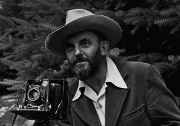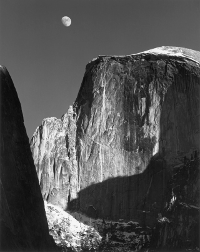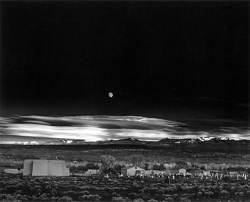Famous Artists of Yosemite
Part 2: Ansel Adams Perhaps the most famous black-and-white photographer of Yosemite landscapes was Ansel Adams. He grew up in the early 20th Century in San Francisco. When he was 4, he lost his balance during an aftershock of the deadly San Francisco earthquake and fell, smashing his nose and breaking it. His nose didn't look the same after that, and this led to his being a shy boy who had trouble fitting in at school. At age 12, he taught himself to read the music and to play the piano. He thought he was going to make a living as a pianist. At the same time, his parents encouraged him to keep studying and to explore nature. He enjoyed walking in the San Francisco Bay area, and this love for the outdoors would inspire his greatest works. 
In 1916, he made his first visit to the Yosemite Valley and surrounding areas. He continued his love of hiking and climbing, combining them with a newfound appreciation for photography, using a camera that his parents had given him. A bout with the Spanish flu during the 1918 pandemic kept him bedridden for a time, but he soon returned to the outdoors. He joined the Sierra Club in 1919 and started spending summers in the Yosemite Valley, making friends in the Sierra Club. He met Virginia Best in Yosemite; they were married in 1928 and had two children. Adams's first published photographs and writings appeared in the 1922 Sierra Club Bulletin. Eight years later, he starred in a one-man photography exhibition at Club headquarters in San Francisco. An association with San Francisco arts patron Albert Bender created in Adams the desire to pursue photography as a career. 
He soon met other famous photographers, notably Alfred Stieglitz, Paul Strand, and Edward Weston. Adams spent a good deal of time in New York during the 1930s and 1940s, showing his work in galleries and writing articles for the magazine Camera Craft. He also wrote a book, Making a Photograph, that first appeared in 1935, and in the 1950s was a founder of the influential magazine Aperture. In all, he produced 10 technical manuals on the art of photography. A collaboration with writer Nancy Newhall produced the book This Is the American Earth, which helped launch the environmental movement in America. He had also met acclaimed painter Georgia O'Keefe; the two became lifelong friends. Adams entered into a contract with the Department of the Interior in 1941 to take photographs of national park and other outdoor scenes in order to produce items to hand on the wall of the department's new building. In 1946, he received a fellowship from the Guggenheim Museum to photograph every national park; he captured all but Florida Everglades National Park. Adams is known as a creator, along with Fred Archer, of the Zone System of photography, a scientifically driven method of determining the relationship between the way the photographer "sees" the subject of a photograph and the way the subject appears in the final result. Earlier, he and Weston, along with Willard Van Dyke, had created Group f/64, a short-lived yet influential San Francisco Bay Area group that sought to employ modernistic approaches to photographing things in nature. 
Adams died in 1984. His autobiography was unfinished and was completed by his editor, Mary Street Alinder, after his death. An avid communicator, he is said to have written an estimated 100,000 cards and letters. The books that contain his name as author or his works as writer or photographer number in the several dozens. He is thought to have made more than 1,300 unique prints, most in his preferred large format. One print, Moonrise, sold in 2006 at a Sotheby's auction in New York for $609,600. He is perhaps most well-known for his photographs of the American West, in particular his beloved Yosemite Valley. Among the honors bestowed on Ansel Adams are these:
First page > Thomas Ayres and Thomas Hill > Page 1, 2 |
|
Social Studies for Kids
copyright 2002–2026
David White




